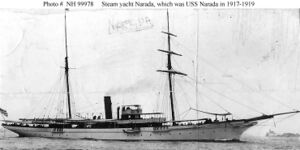Engineering:USS Narada (SP-161)

| |
| History | |
|---|---|
| Name: | USS Narada |
| Namesake: | Narada |
| Builder: | Ramage & Ferguson, Leith |
| Launched: | 30 May 1889 |
| Completed: | 1889 |
| Acquired: | 30 June 1917 |
| Commissioned: | 12 October 1917 |
| Decommissioned: | 13 January 1919 |
| Fate: | Returned to owner 4 February 1919 |
| Notes: |
|
| General characteristics | |
| Type: | Patrol vessel |
| Tonnage: | 505 GRT[1] |
| Length: | 224 ft (68 m) |
| Beam: | 27 ft (8.2 m) |
| Draft: | 15 ft 9 in (4.80 m) |
| Propulsion: | Steam engine |
| Speed: | 12 knots (22 km/h; 14 mph) |
USS Narada (SP-161) was a steam yacht that served in the United States Navy as a patrol vessel from 1917 to 1919.
Narada was built as the wooden-hulled, steam-powered civilian yacht SS Semiramis by Ramage & Ferguson at Leith, Scotland, being launched on 30 May 1889. She later was renamed SS Margarita and then SS Narada. The U.S. Navy purchased Narada from her owner, Mr. Henry D. Walters of Baltimore, Maryland, on 30 June 1917 for use as a patrol vessel during World War I. She was commissioned on 12 October 1917 as USS Narada (SP-161).
During her entire period of naval service, Narada was based at New London, Connecticut, for experimental submarine signal work.
After completion of this service, Narada departed for New York City , arriving there on 13 January 1919. She was decommissioned the same day and returned to her owner on 4 February 1919.
Notes
- ↑ the Dictionary of American Naval Fighting Ships (at http://www.history.navy.mil/danfs/n1/narada.htm) reports that the ship's displacement was 505 tons and NavSource Online (at http://www.navsource.org/archives/12/170161.htm) repeats this, but the Naval Historical Center Online Library of Selected Images (at http://www.history.navy.mil/photos/sh-usn/usnsh-n/sp161.htm) indicates that this figure represents her gross tonnage, a more likely measurement for a yacht.
References
- This article incorporates text from the public domain Dictionary of American Naval Fighting Ships. The entry can be found here.
- Department of the Navy Naval Historical Center Online Library of Selected Images: U.S. Navy Ships: USS Narada (SP-161), 1917-1919. Previously a civilian yacht named Semiramis, Margarita and Narada.
- NavSource Online: Section Patrol Craft Photo Archive: Narada (SP 161)

